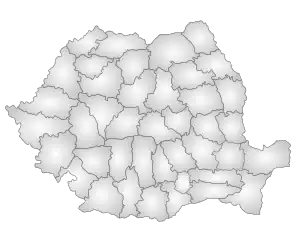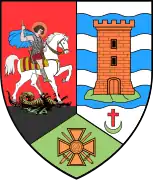Giurgiu County
Județul Giurgiu | |
|---|---|
County | |
 Entering Giurgiu County across the Friendship Bridge from Bulgaria | |
 Flag .svg.png.webp) Coat of arms | |
 | |
| Coordinates: 44°10′N 25°54′E / 44.16°N 25.9°E | |
| Country | |
| Development region1 | Sud |
| Historic region | Muntenia |
| Capital city (Reședință de județ) | Giurgiu |
| Created | 1981 |
| Government | |
| • Type | County Board |
| • President of the County Board | Dumitru Beianu (PNL) |
| • Prefect2 | Aneta Matei |
| Area | |
| • Total | 3,526 km2 (1,361 sq mi) |
| • Rank | 40th in Romania |
| Population (2021-12-01)[1] | |
| • Total | 262,066 |
| • Rank | 38th in Romania |
| • Density | 74/km2 (190/sq mi) |
| Time zone | UTC+2 (EET) |
| • Summer (DST) | UTC+3 (EEST) |
| Postal Code | 08wxyz3 |
| Area code | +40 x464 |
| Car Plates | GR5 |
| GDP | US$1.657 billion (2015) |
| GDP/capita | US$6,242 (2015) |
| Website | County Board County Prefecture |
| 1The developing regions of Romania have no administrative role. They were formed to attract funds from the European Union 2 as of 2007, the Prefect is not a politician, but a public functionary. He (or she) is not allowed to be a member of a political party, and is banned from any political activity in the first six months after the resignation (or exclusion) from the public functionary corps 3w, x, y, and z are digits that indicate the city, the street, part of the street, or even the building of the address 4x is a digit indicating the operator: 2 for the former national operator, Romtelecom, and 3 for the other ground telephone networks 5used on both the plates of the vehicles that operate only in the county limits (like utility vehicles, ATVs, etc.), and the ones used outside the county | |
Giurgiu (Romanian pronunciation: [ˈdʒjurdʒju] ⓘ) is a county (județ) of Romania on the border with Bulgaria, in Muntenia, with the capital city at Giurgiu.
Demographics
In 2011, it had a population of 265,494 and the population density was 75.3/km2 (195.0/sq mi).
| Year | County population[3] |
|---|---|
| 1948 | 313,793 |
| 1956 | 325,045 |
| 1966 | 320,120 |
| 1977 | 327,494 |
| 1992 | 313,084 |
| 2002 | 297,859 |
| 2011 | 265,494 |
| 2021 | 262,066 |
Geography
This county has a total area of 3,526 km2 (1,361 sq mi).
The county is situated on a plain – the Southern part of the Wallachian Plain. The landscape is flat, crossed by small rivers. The southern part is the valley of the Danube which forms the border with Bulgaria. In the North, the Argeș River and Dâmbovița River flow.
Neighbours
- Călărași County in the East.
- Teleorman County in the West.
- Ilfov County and Dâmbovița County in the North.
- Bulgaria in the South – Ruse Province and Silistra Province.
Economy
The county has two big areas of development: one close to the city of Giurgiu – The Free Trade Zone Giurgiu, and one in the North of the county due to its proximity with Bucharest.
The predominant industries in the county are:
- Food and beverages industry.
- Textile industry.
- Chemical industry.
- Wood and furniture industry.
- Mechanical components industry.
Agriculture is the main occupation in the county. Both extensive agriculture, and small scale (for Bucharest markets), is practiced. 59% of the cultivated surface is irrigated.
Tourism
The county recently became famous for its lăutari, especially the group Taraful Haiducilor.
The main tourist destinations are:
The city of Giurgiu
Here the tourists can visit:
- The Clock Tower, made by the Turks when the Giurgiu was a raya
- The Historical Museum
- The theatre "Valah"
- The first bridge built in angel from Europe, over the Canalul Sfântul Gheorghe and Canalul Plantelor, with a specific construction over 100 years old; near this bridge is a new one from 2007
- The Friendship Bridge over the Danube between Giurgiu and Ruse, Bulgaria
- The churches painted by important painters like Grigorescu
- The fluvial station on the Danube river "Port Giurgiu"
- The street "Strada Gării" filled with markets
- The beautiful parks from town where many statues and fountains can be found
- Fishing along the Danube
- The Călugăreni area
- The monasteries from Giurgiu and Comana

Politics
The Giurgiu County Council, renewed at the 2020 local elections, consists of 30 counsellors, with the following party composition:[4]
| Party | Seats | Current County Council | ||||||||||||||||||
|---|---|---|---|---|---|---|---|---|---|---|---|---|---|---|---|---|---|---|---|---|
| National Liberal Party (PNL) | 18 | |||||||||||||||||||
| Social Democratic Party (PSD) | 12 | |||||||||||||||||||
Administrative divisions
Giurgiu County has 1 municipality, 2 towns, and 51 communes:
- Municipalities
- Giurgiu – capital city; population: 54,655 (as of 2011)
- Towns
- Communes
- Adunații-Copăceni
- Băneasa
- Bolintin-Deal
- Bucșani
- Bulbucata
- Buturugeni
- Călugăreni
- Clejani
- Colibași
- Comana
- Cosoba
- Crevedia Mare
- Daia
- Florești-Stoenești
- Frătești
- Găiseni
- Găujani
- Ghimpați
- Gogoșari
- Gostinari
- Gostinu
- Grădinari
- Greaca
- Herăşti
- Hotarele
- Iepurești
- Isvoarele
- Izvoarele
- Joița
- Letca Nouă
- Malu
- Mârșa
- Mihai Bravu
- Ogrezeni
- Oinacu
- Prundu
- Putineiu
- Răsuceni
- Roata de Jos
- Săbăreni
- Schitu
- Singureni
- Slobozia
- Stănești
- Stoenești
- Toporu
- Ulmi
- Valea Dragului
- Vânătorii Mici
- Vărăști
- Vedea
References
- ↑ "Populaţia rezidentă după grupa de vârstă, pe județe și municipii, orașe, comune, la 1 decembrie 2021" (XLS). National Institute of Statistics.
- ↑ National Institute of Statistics, "Populația după etnie" Archived 16 August 2009 at the Wayback Machine
- ↑ National Institute of Statistics, "Populația la recensămintele din anii 1948, 1956, 1966, 1977, 1992 şi 2002" Archived 22 September 2006 at the Wayback Machine
- ↑ "Rezultatele finale ale alegerilor locale din 2020" (Json) (in Romanian). Autoritatea Electorală Permanentă. Retrieved 2 November 2020.



